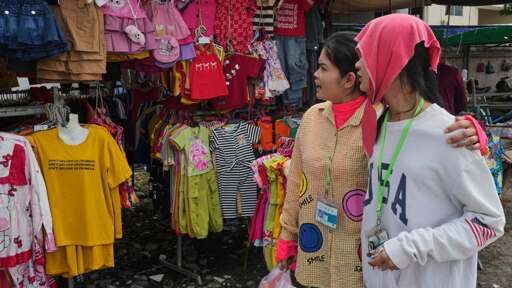NEW YORK (AP) — Sending children back to school in new sneakers, jeans and T-shirts is likely to cost U.S. families significantly more this fall if the bespoke tariffs President Donald Trump put on leading exporters take effect as planned, American industry groups warn.
About 97% of the clothes and shoes purchased in the U.S. are imported, predominantly from Asia, the American Apparel & Footwear Association said, citing its most recent data. Walmart, Gap Inc., Lululemon and Nike are a few of the companies that have a majority of their clothing made in Asian countries.
Those same garment-making hubs took a big hit under the president’s plan to punish individual countries for trade imbalances. For all Chinese goods, that meant tariffs of at least 54%. He set the import tax rates for Vietnam and neighboring Cambodia at 46% and 49%, and products from Bangladesh and Indonesia at 37% and 32%.
Working with foreign factories has kept labor costs down for U.S. companies in the fashion trade, but neither they nor their overseas suppliers are likely to absorb new costs that high. India, Indonesia, Pakistan and Sri Lanka also got slapped with high tariffs so aren’t immediate sourcing alternatives.



We have a superabundance of clothes. People have enormous closets full of lightly worn clothing. We build entire second and third iteration storefronts for outlets and second hand clothing. We have so much extra clothing that we regularly give it away for free.
Of all the things to worry about the US running short on, cloths shouldn’t be anywhere near the top of the list.
People who lack clothing aren’t short on cheap clothing, they’re short on homes to keep their seasonal wear.
Yep. Anyone see all the clothes and shoes floating around in the sea from the secondary market in that movie “Buy Now”?
I went to a thrift store recently and the amount of clothes there that looked nearly-new…it was crazy. Went to an army surplus store today and the used stuff was pretty well constructed and priced fairly well. Some of the new stuff they had was kind of on the high end, but didn’t seem to be hit by tariffs yet.
Most of it is fast fashion made from inferior material in a haphazard manner.
Which is worse when you consider how many microplastic particles are entering the water through clothes washing alone…
Yeah there’s not really a need for new clothes for most people. Unless you are me and you have a shit tonne of clothes from middle school and highschool that are theoretically wearable but I should really just fucken donate.